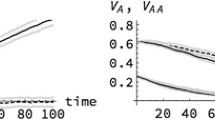Summary
A theoretical investigation has been made of the influence of population size (N) and recombination fraction (c) on linkage disequilibrium (D) between a pair of loci. Two situations were studied: (i) where both loci had no effect on fitness and (ii) where they showed heterozygote superiority, but no epistacy.
If the populations are initially in linkage equilibrium, then the mean value ofD remains zero with inbreeding, but the mean ofD 2 increases to a maximum value and decreases until fixation is reached at both loci. The tighter the linkage and the greater the selection, then the later is the maximum in the mean ofD 2 reached, and the larger its value. The correlation of gene frequencies,r, in the population of gametes within segregating lines was also studied. It was found that, for a range of selection intensities and initial gene frequencies, the mean value ofr 2 was determined almost entirely byN c and time, measured proportional toN.
The implication of these results on observations of linkage disequilibrium in natural populations is discussed.
Zusammenfassung
Es wurde eine theoretische Untersuchung über den Einfluß der Populationsgröße (N) und der Rekombinationsfraktion (c) auf das Koppelungs-Ungleichgewicht (D) zwischen einem Paar von Loci angestellt. Die nachfolgenden zwei Situationen wurden studiert:
-
1.
Beide Loci haben keinen Effekt auf die Fitness.
-
2.
Die Heterozygoten zeigen Überlegenheit, jedoch keine Epistasie.
Befinden sich die Populationen in einem ursprünglichen Koppelungsgleichgewicht, so bleibt der mittlere Wert vonD bei Inzucht gleich null, jedoch steigt das Mittel vonD 2 bis zu einem Maximalwert und fällt, bis die Fixierung an beiden Loci erreicht worden ist. Je enger die Koppelung und je stärker die Selektion ist, desto später wird das Maximum im Mittel vonD 2 erreicht und desto größer ist sein Wert. Ferner wurde die Korrelation von Genfrequenzen,r, in der Population von Gameten innerhalb spaltender Linien untersucht. Es wurde gefunden, daß der mittlere Wert vonr 2 für einen Bereich von Selektionsintensitäten und ursprünglichen Genfrequenzen praktisch vollkommen bestimmt wurde durchNc und die Zeit, gemessen proportional zuN. Abschließend wird die Bedeutung dieser Ergebnisse für Beobachtungen von Koppelungs-Ungleichgewichten in natürlichen Populationen diskutiert.
Similar content being viewed by others
References
Bennett, H. J.: On the theory of random mating. Ann. Eugenics18, 311–317 (1954).
Felsenstein, J.: The effect of linkage on directional selection. Genetics52, 349–363 (1965).
Geiringer, H.: On the probability theory of linkage in Mendelian heredity. Ann. Math. Statist.15, 25–57 (1944).
Hill, W. G., andA. Robertson: The effect of linkage on limits to artificial selection. Genet. Res.8, 269–294 (1966).
Kimura, M.: Random drift in a multi-allelic locus. Evolution9, 419–435 (1955).
Kimura, M.: A probability method for treating inbreeding systems, especially with linked genes. Biometrics19, 1–17 (1963).
Lewontin, R. C.: The interaction of selection and linkage. I. General considerations; heterotic models. Genetics49, 49–67 (1964).
Lewontin, R. C., andK. Kojima: The evolutionary dynamics of complex polymorphisms. Evolution14, 458–472 (1960).
Nei, M.: Effect of selection on the components of genetic variance. In: Statistical Genetics and Plant Breeding, ed. byW. D. Hanson andH. F. Robinson: Publ. 982, National Academy of Sciences, National Research Council, Washington, D.C., pp. 501–515 (1963).
Robertson, A.: The effect of inbreeding on the variation due to recessive genes. Genetics37, 189–207 (1952).
Robertson, A.: Selection for heterozygotes in small populations. Genetics47, 1291–1300 (1962).
Robertson, A., andW. G. Hill: The effects of inbreeding at loci with heterozygote advantage. Genetics (submitted for publication 1968).
Wright, S.: Inbreeding and recombination. Proc. Nat. Acad. Sci., Wash.19, 420–433 (1933).
Author information
Authors and Affiliations
Additional information
Member of the A.R.C. Unit of Animal Genetics.
Rights and permissions
About this article
Cite this article
Hill, W.G., Robertson, A. Linkage disequilibrium in finite populations. Theoret. Appl. Genetics 38, 226–231 (1968). https://doi.org/10.1007/BF01245622
Issue Date:
DOI: https://doi.org/10.1007/BF01245622




